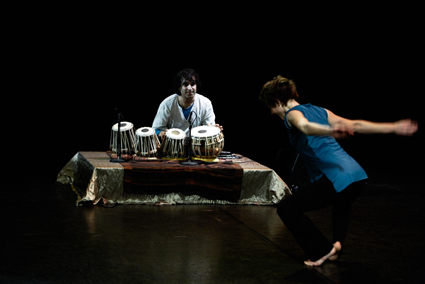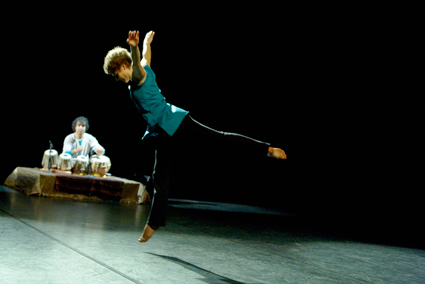when opposites meet
keith gallasch: theatre of rhythm & dance, game on

Bobby Singh, Miranda Wheen, Game On
photo Shane Rozario
Bobby Singh, Miranda Wheen, Game On
CROSS-CULTURAL COLLABORATIONS CAN YIELD A VARIETY OF OUTCOMES, DETERMINED BY INTENTION (LET’S AIM FOR SYNTHESIS OR JUXTAPOSITION) OR CHANCE (LET’S SEE WHAT HAPPENS). THE TITLE OF CHOREOGRAPHER ANNALOUISE PAUL’S GAME ON SUGGESTS, AS IN SPORT, A CHALLENGE WITH AN UNPREDICTABLE RESULT. WHAT HAPPENS WHEN “A 3,000 YEAR OLD CLASSICAL INDIAN MUSIC TRADITION MEETS A WESTERN CONTEMPORARY DANCE FORM, 100 YEARS YOUNG?”, ASKS PAUL IN HER PROGRAM NOTE.
The spatial structure of Game On, with tabla virtuoso Bobby Singh surrounded by his instruments on a low platform to one side of The Studio floor and dancer Miranda Wheen on the other, suggests a face-off, one that in the event unfolds in individual displays and then escalating episodes of interplay and good-humoured provocation and gentle mockery. The result is not a hybrid (of the kind you might expect from, say, Akram Khan and his various collaborators) but a conversation between two forms that very much retain their own shape and integrity while driving each other to new rhythmic extremes and subtleties.

Bobby Singh, Miranda Wheen, Game On
photo Shane Rozario
Bobby Singh, Miranda Wheen, Game On
The work’s dramaturgical structure suggests improvisation with its casual pauses, smattering of chat and the artists’ turn-taking at triggering episodes, or when it’s clear, for example, that Wheen has been fully extended and is happy to rest as Singh shapes material for the next encounter or plays a solo she does not respond to. At the outset the improvisational gestures and tone feel somewhat forced, as if prepared instead of spontaneous, making the early part of Game On feel too tentative for too long.
What is never in doubt is the spirit and expertise of the performers. As an audience member commented, it was wonderful to hear Singh uncharacteristically playing without other musicians, allowing us to fully focus on the timbral range and surprising harmonics he can draw from his variously sized tabla. Wheen met Annalouise Paul’s considerable choreographic challenge and Singh’s rhythmic demands with total fleet-footed commitment, working much of the stage space with fully extended limbs, floor spins and rolls, long leaps and ripples that flowed through her body. The response to rhythmic change was never literal, neither artist simply speeding up because the other was moving or playing faster, instead producing a marked visual or sonic counterpoint.
In the passage that most fully engaged me, Wheen danced very close to Singh with movements that lowered her centre of gravity, legs bending deep, knees out, arms extended, hands articulated as if to suggest an Asian influence in a moment of suggestive if doubtless impressionistic cultural synthesis given that Wheen was not literally imitating Indian dance. Game On proved to be an intriguing experience if an uncertain one about precisely where Indian music and western dance might actually meet. Nonetheless Annalouise Paul’s Theatre of Rhythm and Dance offers the promise of further worthwhile and much needed cross-cultural explorations drawing on the skills and passions of talented artists.
Theatre of Rhythm and Dance, Game On, choreography, concept Annalouise Paul, choreographic collaborator, dancer Miranda Wheen, classical Indian tabla Bobby Singh, musical dramaturgy Peter Kennard, lighting Stephen Hawker, costume Jai Saunders, producer Sam Hawker, Arts Radar; The Studio, Sydney Opera House, Aug 13-15, www.annalouisepaul.com.au
RealTime issue #105 Oct-Nov 2011 pg. web






